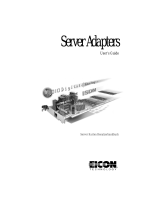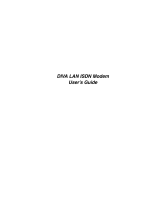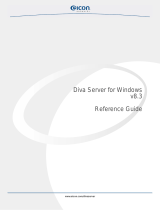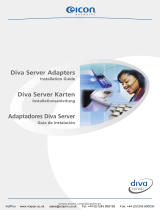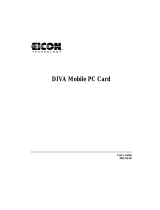Page is loading ...

2
Fourth Edition (March 2001) 206-362-04
Diva and Eicon are either registered trademarks or trademarks of Eicon Networks Corporation.
Microsoft, Windows, and Windows NT are either registered trademarks or trademarks of
Microsoft Corporation in the United States and/or other countries.
Adobe and Acrobat are either registered trademarks or trademarks of Adobe Systems Incorporated
in the United States and/or other countries.
Apple and Macintosh are trademarks of Apple Computer, Inc. in the United States and/or other
countries.
IBM is a registered trademark of IBM Corporation in the United States and/or other countries.
All other brand and product names are trademarks or registered trademarks of their respective
owners.
Changes are periodically made to the information herein; these changes will be incorporated into
new editions of the publication. Eicon Networks Corporation may make improvements and/or
changes in the products and/or programs described in this publication at any time.
If you have comments on this manual or the products it describes, address them to:
Eicon Networks Corporation
Attention: Technical Publications
9800 Cavendish Blvd.
Montreal, Quebec
Canada H4M 2V9
Eicon Networks Corporation may use or distribute whatever information you supply in any way it
believes appropriate without incurring any obligations to you.
Eicon Networks Corporation is a business unit of i-data international a-s.
Copyright © 1999-2001 Eicon Networks Corporation. All rights reserved, including those to
reproduce this publication or parts thereof in any form without permission in writing from Eicon
Networks Corporation.

Page 3
Contents
Introduction ...............................................................................................................................4
Introducing the Diva 2430 ADSL Modem................................................................................................................. 5
Package Contents.................................................................................................................................................... 6
Setup ..........................................................................................................................................7
Overview .................................................................................................................................................................. 8
Connecting Microfilters ............................................................................................................................................ 9
USB Setup ............................................................................................................................................................. 10
Ethernet Setup ....................................................................................................................................................... 15
Optional: Install the Diva Assistant......................................................................................................................... 18
LAN Setup.............................................................................................................................................................. 20
Configuring Settings via the Web Interface............................................................................................................ 22
TCP/IP Setup ......................................................................................................................................................... 26
Troubleshooting...................................................................................................................................................... 31
Using your Diva 2430..............................................................................................................33
About the Diva Assistant........................................................................................................................................ 34
Indicator Lights....................................................................................................................................................... 37
Resetting the Device .............................................................................................................................................. 38
Web-based Configuration Interface.......................................................................................39
Overview ................................................................................................................................................................ 40
Starting the Web-based Configuration Interface .................................................................................................... 41
Saving and restoring configuration files ................................................................................................................. 43
Upgrading Firmware............................................................................................................................................... 44
Resetting to Factory Defaults................................................................................................................................. 46
Advanced Topics.....................................................................................................................47
Security .................................................................................................................................................................. 48
Virtual Private Networking...................................................................................................................................... 53
Specifications and Regulatory Information .......................................................................... 58
Specifications......................................................................................................................................................... 59
Regulatory Information........................................................................................................................................... 62
Index.........................................................................................................................................67

Introduction: Introducing the Diva 2430 ADSL Modem Page 5
Introducing the Diva 2430 ADSL Modem
The Diva 2430 ADSL Modem provides fast access to the Internet via ADSL and is
perfect for home users and small office / home office users. It is easy to set up and has
many features that will help you get the most out of your ADSL line.
The following provides a brief overview of the many features of the Diva 2430.
Setup and Configuration Features
•
Easy to Set Up:
Installation is a simple and straightforward procedure. You will be
up and running in just a few minutes.
•
Web-base Configuration:
If configuration is required, the Diva 2430 settings can
be changed using a web browser.
ADSL and Network Features
•
Support for Full-rate and G.Lite ADSL:
The Diva 2430 is an ADSL (Asymmetric
Digital Subscriber Line) device supporting transfer of up to 8 Mbps. Two popular
versions of ADSL are built in to the Diva 2430, Full-rate and G.Lite.
Full-rate (G.992.1 and T1.413 Issue 2) has a maximum download rate of 8 Mbps and
a maximum upload rate of 820 Kbps. G.Lite (G.992.2) has a maximum download
rate of 1.5 Mbps and a maximum upload rate of 512 Kbps.
Both Full-rate and G.Lite on the Diva 2430 can work with or without a splitter. See
Package Contents
on page 6 for more information on how Internet access is
provided via ADSL.
•
ATM Support:
The Diva 2430 supports up to eight simultaneous virtual circuit (VC)
connections.
•
DHCP Support:
The computers connected to the Diva 2430 must be configured as
DHCP clients. The Diva 2430 then passes on DHCP requests to your provider’s
DHCP server, but can also assign IP addresses if your provider’s DHCP server is not
available.
Hardware Features
•
USB and Ethernet Ports:
The Diva 2430 can connect to your computer through
either a USB port or an Ethernet port. Setup via either port is simple and easy. You
can also connect the Diva 2430 to an Ethernet hub, giving all computers on the
network access to the Internet.
•
Simultaneous Port Usage:
The USB and Ethernet ports can be used simultaneously.
You can connect one computer to the Ethernet port and another to the USB port, and
both devices can access the ADSL line when needed or exchange data between the
two local computers.
•
Upgradable Firmware:
The Diva 2430’s firmware (a set of software instructions
that tells the device how to operate) is stored in flash memory on the device. This
makes it easy to upgrade the firmware should it become necessary to do so.

Introduction: Package Contents Page 6
Package Contents
Your package should contain the following.
*Microfilters may or may not be included with your package. If your ADSL line does
not use a splitter, microfilters must be connected to all analog devices to reduce
background noise. Contact your provider for more details.
Diva 2430
Ethernet Cable (Yellow) USB Cable
ADSL Phone Cable Power Adapter
CD-ROM Quickstart
Microfilters* Phone Adapter
(where required)
In certain countries, a
phone adapter is provided
to enable you to connect
your Diva 2430 to the
telephone outlet standard
for your region.

Page 7
Setup
In This Section
Overview
.......................................................................................................................8
Connecting Microfilters
..............................................................................................9
USB Setup
..................................................................................................................10
Ethernet Setup
...........................................................................................................15
Optional: Install the Diva Assistant
.........................................................................18
LAN Setup
..................................................................................................................20
Configuring Settings via the Web Interface
............................................................22
TCP/IP Setup
.............................................................................................................26
Troubleshooting
.........................................................................................................31

Setup: Overview Page 8
Overview
This chapter explains how to connect the Diva 2430 to a single computer or to a local
area network.
Connecting to Both Ports
Once you connect a computer to either the USB or Ethernet port, you can connect a
second computer to the unused port without reconfiguring the device. However, to
ensure proper operation, connect only one computer and verify that the device is
working correctly before connecting a second computer.
Hardware Requirements
In addition, the normal Windows setup includes the installation of the Diva Assistant.
The Diva Assistant software is a Windows-only application that facilitates the
management of the Diva 2430. To install and run this software you will need an
IBM®-compatible 486 or Pentium-based computer equipped with a CD-ROM drive,
running Microsoft® Windows 95 or later.
Software Requirements
The Diva 2430 is configured using a web browser. Minimum requirements are
Netscape 4.0 or Internet Explorer 4 (or later versions). An installer for Internet Explorer
is included on the Diva 2430 CD-ROM for computers running Windows.
(Windows NT® 4.0 requires SP3 or later, available at http://www.microsoft.com/.)
Connection Type Requirements
Computer via
USB port
• An available USB Port.
• Windows® 98, Windows 2000, or Windows Me. The
Diva 2430 does not support USB for Windows 95,
Macintosh®, or other systems.
Computer via
Ethernet port
• Any computer and operating system capable of supporting a
10BASE-T Ethernet card and the TCP/IP protocol.
• A 10BASE-T Ethernet network interface card, properly
installed and configured to use the TCP/IP protocol. Consult
the documentation that came with your card for instructions
on how to do this. A 100 Mbps Ethernet card can only be
connected to the Diva 2430 if it supports auto-sensing.
• TCP/IP communications protocol installed and configured.

Setup: Connecting Microfilters Page 9
Connecting Microfilters
Before installing the Diva 2430, be sure to install microfilters on all telephone devices,
if required. Contact your ADSL provider if you are unsure if microfilters are needed
for your installation.
About Microfilters
A microfilter is a small device designed to reduce interference between ADSL signals
and your regular telephone signals.
The use of microfilters is only required if your ADSL modem and your telephone
devices share the same wiring. This is known as ‘splitterless’ ADSL. Without
microfilters, ADSL may cause background noise on your phone, Additionally, ADSL
data transfer may be interrupted by phone calls.
If microfilters are required, you must install one on each telephone device that shares
the same wiring as the ADSL signals, including telephones, answering machines, and
fax machines.
If your installation uses a splitter, it should not be necessary to use microfilters as
ADSL data is carried on separate wiring up to the point of entry to your location.
Your package may or may not include a microfilter. If you are unsure as to how to
connect the microfilter, or whether or not one is necessary, contact your
ADSL provider.
Connecting the Microfilters
To install the microfilter, plug your phone into the microfilter, then plug the microfilter
into your telephone jack, as shown below.
You must use one microfilter per telephone device in your location. Do not install a
microfilter on the cable that connects your ADSL device to the telephone jack.

Setup: USB Setup Page 10
USB Setup
Note:
The USB port can only be used with systems running Windows 98,
Windows 2000, or Windows Me.
If you are using Windows 98, Windows 2000, or Windows Me, you have the option of
connecting the device to your computer’s USB port. This is described in the following
procedure.
Once set up, you can then connect a second computer that supports Ethernet to the
Diva 2430’s Ethernet port. To ensure a smooth installation, first install a computer
using one port only, to make sure the device is working properly.
Setup involves the following steps:
Step 1: Connect the Cables
................................................................... 11
Step 2: Install USB Drivers
................................................................... 12
Step 3: Test Internet Access
.................................................................. 14
Note:
The Diva 2430 does not support USB under Windows 95, Macintosh, or other operating
systems. For these systems, see
Ethernet Setup
on page 15.

Setup: USB Setup Page 11
Step 1: Connect the Cables
Consult the following diagram when connecting the cables. Do not connect one
computer to both ports on the device.
Procedure
Leave your computer on during the installation. Once you connect the Diva 2430 to
your computer, Windows will automatically detect the device and request device
driver information, which is provided on the Diva 2430 CD-ROM.
You may be required to insert your Windows installation CD-ROM during installation.
1.
Insert the Diva 2430 CD-ROM into your CD-ROM drive.
2.
Connect the Diva 2430 to an electrical outlet using the power adapter. The power
connector is labelled on the Diva 2430.
3.
Connect the Diva 2430 to your ADSL telephone outlet (RJ11) using the supplied
ADSL cable. The ADSL port is labelled on the Diva 2430.
When you first connect the ADSL cable, the ADSL light on the front panel will
flash to indicate that the Diva 2430 is attempting to establish an ADSL connection.
When the ADSL light stops flashing and stays on, the ADSL connection has been
established. If the ADSL light continues to flash, the Diva 2430 is having difficulty
establishing the ADSL connection.
4.
Connect the flat end of the USB cable into any available USB port on your computer,
then plug the other end into the Diva 2430’s USB port. The USB port is labelled
on the Diva 2430.
5.
Once the USB cable is connected, Windows recognizes the device. See
Step 2:
Install USB Drivers
on the following page to continue.
USB
Cable
Power
Adapter
ADSL
Cable
Note:
Do not install a microfilter between the Diva 2430 and the telephone jack.
Microfilters, if necessary, are for use between regular telephone devices and telephone
jacks only.

Setup: USB Setup Page 12
Step 2: Install USB Drivers
1.
Once the USB cable is connected, the ‘New Hardware Found’ window appears,
followed by the ‘Add New Hardware Wizard’ window.
2.
Click ‘Next’ to begin.
3.
Select ‘Search for the best driver for your device’ then click ‘Next’.
4.
Select ‘Specify a location’ and clear other options.
Select this option
Clear these options
Select this option

Setup: USB Setup Page 13
5.
Click ‘Browse’ and go to the ‘USB’ folder on the Diva 2430 CD-ROM.
• If you are using Windows 98, select ‘WIN98’.
• If you are using Windows 2000, select ‘WIN2000’.
• If you are using Windows Millennium Edition, select ‘WINME’.
6.
Click ‘OK’, then click ‘Next’. Windows identifies the driver as an ‘Eicon Diva 2430
Adapter’.
7.
Click ‘Next’ to begin installation of the driver.
8.
Once installation is complete, click ‘Finish’.
If you are asked to restart your computer, do so.
9.
To continue, go to
Step 3: Test Internet Access
on the following page.
Note:
You may be asked to insert your Windows installation CD-ROM while the driver is
being installed. If a version conflict is reported (a file being copied is older than an existing
file), it is recommended that you keep the existing file.

Setup: USB Setup Page 14
Step 3: Test Internet Access
The Diva 2430’s default settings may already grant you Internet access. Try accessing
an external web site using your browser, such as the Diva 2430 web site at:
http://www.eicon.com
• If successful, you do not need to change any settings.
• If you receive a ‘page not found’ or similar error, reboot your computer and try again.
Your computer may not have acquired an IP address from your provider’s DHCP
server the first time you installed the device; rebooting will force a new request.
• Internet access from some providers may require that you install PPP over Ethernet
(PPPoE) software (not included with the Diva 2430). Contact your provider for more
information.
• If you still cannot access the Internet, you will need to inspect the Diva 2430’s
configuration settings. This procedure is described in
Configuring Settings via the
Web Interface
on page 22. As most settings depend on the provisioning of your
ADSL line, you should contact your ADSL provider to determine what the settings
should be.

Setup: Ethernet Setup Page 15
Ethernet Setup
The procedure in the following section describes how to set up the Diva 2430 using
any system equipped with an Ethernet card and capable of communicating via the
TCP/IP protocol. This includes Windows, Macintosh, and Linux. This procedure
assumes your Ethernet card is installed according to the manufacturer’s instructions.
In This Section
Step 1: Connect the cables
.................................................................... 16
Step 2: Test Internet Access
.................................................................. 17

Setup: Ethernet Setup Page 16
Step 1: Connect the cables
Consult the following diagram when connecting the cables. Do not install one
computer to both ports on the device.
Procedure
1.
Connect the Diva 2430 to an electrical outlet using the power adapter. The power
connector is labelled on the Diva 2430.
2.
Connect the Diva 2430 to your ADSL telephone outlet (RJ11) using the supplied
ADSL cable. The ADSL port is labelled on the Diva 2430.
When you first connect the ADSL cable, the ADSL light on the front panel will
flash to indicate that the Diva 2430 is attempting to establish an ADSL connection.
When the ADSL light stops flashing and stays on, the ADSL connection has been
established. If the ADSL light continues to flash, the Diva 2430 is having difficulty
establishing the ADSL connection.
3.
Connect the Diva 2430 to the Ethernet card on your computer using the supplied
yellow Ethernet cable. The Ethernet port is labelled on the back of the
Diva 2430.
If properly connected to your computer, the Diva 2430 Ethernet status light (on the
front panel) should light up.
4.
Verify that you have configured your computer to act as a DHCP client (see
TCP/IP
Setup
on page 26 for more information). Restart your computer, if necessary, to
force the settings to take effect.
5.
To continue, go to
Step 2: Test Internet Access
on the following page.
Ethernet
Cable
(yellow)
Power
Adapter
ADSL
Cable
Note:
Do not install a microfilter between the Diva 2430 and the telephone jack.
Microfilters, if necessary, are to be installed between regular telephone devices
and telephone jacks only.

Setup: Ethernet Setup Page 17
Step 2: Test Internet Access
The Diva 2430’s default settings may already grant you Internet access. Try accessing
an external web site using your browser, such as Eicon Networks’s site at:
http://www.eicon.com
• If successful, you do not need to change any settings.
• If you receive a ‘page not found’ or similar error, reboot your computer and try again.
Your computer may not have acquired an IP address from your provider’s DHCP
server the first time you installed the device; rebooting will force a new request.
• Internet access from some providers may require that you install PPP over Ethernet
(PPPoE) software (not included with the Diva 2430). Contact your provider for more
information.
• If you still cannot access the Internet, you will need to inspect the Diva 2430’s
configuration settings. This procedure is described in
Configuring Settings via the
Web Interface
on page 22. As most settings depend on the provisioning of your
ADSL line, you should contact your ADSL provider to determine what the settings
should be.

Setup: Optional: Install the Diva Assistant Page 18
Optional: Install the Diva Assistant
The Diva Assistant provides convenient access to the web-based configuration
interface via the Windows system tray and also includes online help and utilities. The
Diva Assistant also provides status information for the device. However, you are not
required to use this software in order to access the Internet through your ADSL line.
Note:
The Diva Assistant is very useful when setting up the Diva 2430 on a LAN.
In particular, the Diva Assistant will detect the device over the LAN and ask if you
want to change its LAN IP address. For more information, see
LAN Setup
on
page 20.
Procedure
1.
You must restart your computer once installation is complete. It is suggested that
you quit all running applications.
2.
Insert the Diva 2430 CD-ROM into your computer’s CD-ROM drive. The setup
program should start automatically.
3.
From the ‘Welcome’ screen, click ‘Installation’, then click ‘Diva Software’.
4.
The Diva 2430 Setup Wizard starts.
Note:
If the setup program does not start on its own, double-click ‘My Computer’ on your
desktop, double-click your CD-ROM drive, then double-click the ‘SETUP.EXE’ file.

Setup: Optional: Install the Diva Assistant Page 19
5.
Click ‘Next’ and follow the onscreen instructions.
6.
In the ‘Installation Complete’ window, click ‘Finish’.
7.
After you click ‘Finish’, you will see a message stating that you must restart your
computer before launching the software. Click ‘Yes’.
You may encounter problems with the Diva Assistant if you do not restart your
computer after installation.
Restarting also forces your computer to request a new IP address, which is supplied
by your provider or the device itself. Without the new IP address, you will not be
able to communicate with your device.
8.
Once you restart, the Diva Assistant icon will appear in the system tray. To start the
software, double-click on this icon. For more information on using the Diva
Assistant, see
About the Diva Assistant
on page 34.

Setup: LAN Setup Page 20
LAN Setup
Installing the Diva 2430 on an existing LAN can be extremely simple, or quite
challenging, depending on the complexity of your existing LAN setup. To help you
successfully integrate the Diva 2430 into your setup, this section provides important
points to keep in mind when setting up on a LAN.
However, due to the wide range of networking equipment and topologies that are in
use worldwide, your configuration needs may fall outside the strategy presented here.
In this case, you should contact your network administrator, or other support person to
help you with your installation.
Install using a single computer recommended
Before installing the Diva 2430 on your LAN, it is recommended that you configure
the device using a single non-networked computer. This lets you verify that your
ADSL line is functioning and that you are able to successfully communicate with the
Diva 2430. This also lets you easily change the device IP address if required.
DHCP Server
The Diva 2430 has a built-in DHCP server. When you drop the Diva 2430 into a LAN,
the Diva 2430 senses if another DHCP server exists and de-activates its own DHCP
services. To-reactivate the DHCP server, disable the other server and reset the
Diva 2430.
Cables
To connect the Diva 2430 to a network hub, you need to use a standard,
straight-through Ethernet cable (sold separately). The yellow cable included with your
package is a crossover cable and is used for connecting the Diva 2430 directly to a
computer.
PPPoE Software
If you need to use a PPP over Ethernet client for accessing the Internet, the PPPoE
client must be installed on each computer that requires access.
Changing the LAN IP address
If your LAN uses static IP addressing, or if you are using an existing DHCP server,
you must assign the Diva 2430 a unique IP address before connecting the device to the
LAN. Ensure that this IP address is not going to be assigned to another network
/



